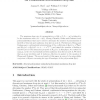Free Online Productivity Tools
i2Speak
i2Symbol
i2OCR
iTex2Img
iWeb2Print
iWeb2Shot
i2Type
iPdf2Split
iPdf2Merge
i2Bopomofo
i2Arabic
i2Style
i2Image
i2PDF
iLatex2Rtf
Sci2ools
EJC
2016
2016
On permutations with bounded drop size
The maximum drop size of a permutation π of [n] = {1, 2, . . . , n} is defined to be the maximum value of i − π(i). Chung, Claesson, Dukes and Graham found polynomials Pk(x) that can be used to determine the number of permutations of [n] with d descents and maximum drop size at most k. Furthermore, Chung and Graham gave combinatorial interpretations of the coefficients of Qk(x) = xkPk(x) and Rn,k(x) = Qk(x)(1 + x + · · · + xk)n−k, and raised the question of finding a bijective proof of the symmetry property of Rn,k(x). In this paper, we construct a map ϕk on the set of permutations with maximum drop size at most k. We show that ϕk is an involution and it induces a bijection in answer to the question of Chung and Graham. The second result of this paper is a proof of a unimodality conjecture of Hyatt concerning the type B analogue of the polynomials Pk(x).
Related Content
| Added | 02 Apr 2016 |
| Updated | 02 Apr 2016 |
| Type | Journal |
| Year | 2016 |
| Where | EJC |
| Authors | Joanna N. Chen, William Y. C. Chen |
Comments (0)

